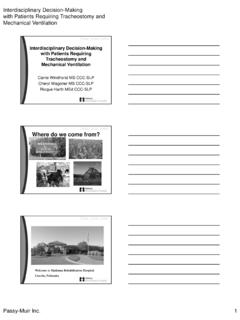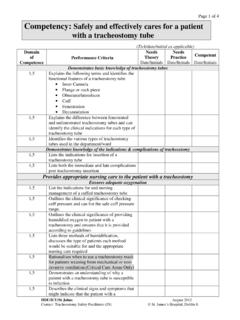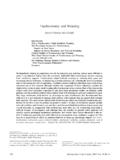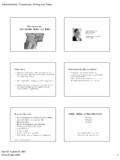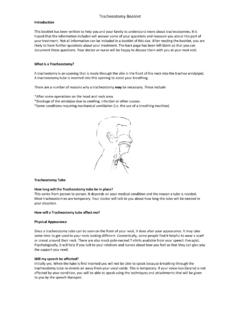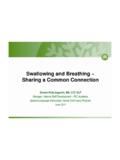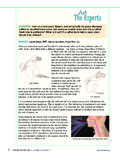Transcription of TRACHEOSTOMY ANAESTHESIA TUTORIAL OF THE …
1 Sign up to receive ATOTW weekly - email TRACHEOSTOMY . ANAESTHESIA TUTORIAL OF THE WEEK 241. 17TH OCTOBER 2011. Dr Rakesh Bhandary, Royal Victoria Infirmary, Newcastle Upon Tyne, UK. Dr Niraj Niranjan, University Hospital of North Durham, UK. Correspondence to QUESTIONS: 1. What is the effect of a TRACHEOSTOMY on anatomical deadspace and work of breathing? 2. What are the advantages and disadvantages of early TRACHEOSTOMY in cases where prolonged mechanical ventilation is predicted? 3. Which patients should have dual cannula TRACHEOSTOMY tubes inserted? 4. When and why should TRACHEOSTOMY tubes be routinely changed? INTRODUCTION. Tracheotomy refers to the surgical opening of the trachea while TRACHEOSTOMY refers to the creation of a stoma at the skin surface, which leads to the trachea. The history of surgical access to the airway is largely one of condemnation. This technique of slashing the throat to save a life was known as semi-slaughter.
2 However, once the technique was perfected as a last resort in largely hopeless cases of diphtheria, the opportunities it offered for medical heroism ensured its place in the surgical armamentarium, such that Fabricius could write in the 17th century, This operation redounds to the honor of the physician and places him on a footing with the Gods . TRACHEOSTOMY was performed in ancient Egypt and is one of the oldest surgical Chevalier Jackson described the principles of TRACHEOSTOMY at the beginning of the 20th Tracheostomies may be temporary or permanent. A temporary TRACHEOSTOMY may be used as a permanent TRACHEOSTOMY however there will still be a communication between the pharynx and the lower airway via the larynx. INDICATIONS FOR TRACHEOSTOMY . 1. Upper airway obstruction. This is no longer the most common indication for TRACHEOSTOMY , owing to the improvement in designs of intubating laryngoscopes and alternative management strategies.
3 Upper airway obstruction may be caused by swelling resulting from burns, anaphylaxis, trauma or infection or as a direct result of facial trauma or fractures. 2. Prolonged ventilation. This is now the most common indication for TRACHEOSTOMY , certainly in the intensive-care setting. A TRACHEOSTOMY is more secure and decreases dead space compared to an oral endotracheal tube, which facilitates weaning from ventilation. The timing of TRACHEOSTOMY for this purpose is still controversial (see comments regarding the TracMan study later in the article). ATOTW 241 TRACHEOSTOMY 17/10/2011 Page 1 of 12. Sign up to receive ATOTW weekly - email 3. To provide pulmonary toilet and/or to protect the airway. Tracheostomies may sometimes be performed for conditions associated with excessive tracheo-bronchial secretions requiring regular secretion clearance by suction. Examples are congestive cardiac failure, bulbar palsy, infections or neurological conditions where cough and swallow are impaired.
4 4. As part of another procedure, for example, head and neck surgery. EFFECTS OF A TRACHEOSTOMY . The larynx is bypassed and so the patient is unable to phonate (unless a valved device is used;. see later). There is decreased anatomical and respiratory dead space, decreasing the work of breathing There is loss of the humidification and filtration function of the nasal mucosa There is an increased risk of respiratory tract infection There is a redundant area above the tracheal opening and below the larynx in which mucus can accumulate and fall back into the lungs. A foreign body reaction can occur causing local inflammation. TIMING OF TRACHEOSTOMY FOR PROLONGED VENTILATION CASES. The timing of TRACHEOSTOMY remains an issue of debate. In a study of TRACHEOSTOMY in mechanically ventilated adult ICU patients, Terragni et al found no statistically significant difference in the rates of ventilator-associated pneumonia with early tracheotomy (after 6-8 days of laryngeal intubation) versus late tracheotomy (after 13-15 days of laryngeal intubation).
5 3. Meanwhile, a large, retrospective cohort analysis including nearly 11,000 critically ill patients evaluated the impact of TRACHEOSTOMY timing on mortality. The authors found a slight overall improvement in survival in patients who underwent TRACHEOSTOMY within the first 10 days of The TracMan study was carried out in the United Kingdom to assess the impact of early (day 1-4 of ICU admission) versus late (day 10 or later) The study included 909 patients from 87. UK hospitals who were expected to stay 7 days or more in the ICU, between March 2006 and December 2008. Patients were randomised to early (n=455) or late (n=454) TRACHEOSTOMY . Patient characteristics were similar across both groups, with respiratory failure the most common cause of admission to the ICU. There was no significant difference in mortality between the early and late TRACHEOSTOMY groups at 30. days (139 versus 141 deaths) or at 2 years post randomisation, with a 74% follow up rate.
6 There was also no significant difference in ICU or hospital length of stay and no significant difference in antibiotic use. However, mean days of sedation were predictably reduced - to days in the early group compared with days in the late group. At the study's presentation, at the 29th International Symposium of Intensive Care and Emergency Medicine, the lead author stated the following: "If you had 100 patients requiring TRACHEOSTOMY , doing it early results in days less sedation overall, but you would perform 48 more, with 3 more procedural complications and no effect on mortality or ICU length of stay.". ATOTW 241 TRACHEOSTOMY 17/10/2011 Page 2 of 12. Sign up to receive ATOTW weekly - email TECHNIQUES FOR INSERTION. TRACHEOSTOMY may be performed using a percutaneous or an open surgical technique. Percutaneous TRACHEOSTOMY is performed by anaesthesiologists or intensivists, usually under fibreoptic bronchoscopic guidance.
7 Open surgical tracheostomies are performed by ENT surgeons and in some countries, trauma surgeons. Percutaneous TRACHEOSTOMY was first described in the late 1950s and 1960s but received widespread acceptance following introduction of commercial kits. Two initial techniques were described a serial dilatational technique described by Ciaglia et al6 in 1985 and a guidewire dilating forceps (GWDF) method described by Griggs and colleagues in 1990. In 2000, Byhahn et al modified the Ciaglia technique by introducing the Blue Rhino7 (Figure 1). This hydrophilically coated, curved dilator allows progressive dilatation of the tracheal stoma in a single step, reducing the risk of posterior tracheal wall injury, intraoperative bleeding and the adverse effect on oxygenation during repeated airway obstruction by sequential dilators. Figure 1. The Blue Rhino single stage dilator (Cook Medical).
8 Percutaneous TRACHEOSTOMY Insertion Many commercial kits are available, all employing a Seldinger guidewire technique for TRACHEOSTOMY tube insertion. Techniques may vary slightly, depending upon operator preference and experience but the basics principles of insertion are described below. ATOTW 241 TRACHEOSTOMY 17/10/2011 Page 3 of 12. Sign up to receive ATOTW weekly - email Percutaneous TRACHEOSTOMY Insertion basic principles 1. Contraindications for percutaneous TRACHEOSTOMY are reviewed (see below). 2. Consent should be obtained where possible patients will frequently not be in a position to give consent. While the issue may be discussed with next of kin, the decision to proceed is made in the patient's best interests. 3. Platelet and coagulation assays are checked and the patient's blood should be group and saved' as bleeding may be a complication of this procedure.
9 Intensive Care Society (UK) guidance recommends the use of a pre-procedure ultrasound to confirm the absence of large blood vessels directly over the planned site of insertion. 4. Nasogastric tube feeding should be stopped for at least two hours and the nasogastric tube should be aspirated to reduce any chance of aspiration of gastric contents. 5. Equipment is assembled. This will include the percutaneous TRACHEOSTOMY set, equipment for emergency re- intubation, a fibreoptic bronchoscope, drapes and sterile skin preparation and a local anaesthetic solution containing a vasocontrictor such as 1% lidocaine with 1:200 000 epinephrine. 6. The procedure requires two clinicians one to operate the bronchoscope and one to perform the TRACHEOSTOMY insertion and assistance from a member of nursing staff familiar with the procedure and the environment to assist with the management of complications.
10 7. Sedation, analgesia and muscle relaxation need to be administered, common examples being propofol, fentanyl and atracurium. 8. The patient is positioned in a way that allows the neck to be extended. This can be achieved by using pillows or towels placed behind their shoulders. The patient should be fully monitored and ventilated with 100% oxygen during the procedure. 9. The cuff of the patient's endotracheal tube is deflated and the tube is withdrawn under direct vision until the tip is just distal to the patient's vocal cords. This removes the endotracheal tube from the operative site. Alternatively, the tube may be exchanged for a laryngeal mask airway (LMA) providing that the patient can be ventilated safely using the device. This may not be the case in patients requiring higher a FiO2, high levels of PEEP or high inspiratory airway pressures. 10. The patient's anatomy should be marked, including the intended level of insertion of the TRACHEOSTOMY .










